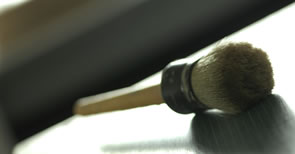SPECIAL FINISHES
"In this world where almost everything we buy is machine made and mass produced, there are few areas of life that afford us the pleasure of commissioning something made by hand. This luxury is still available in choosing a picture frame."
Piers Feetham
Piers Feetham


PAINTED FINISHES
A frame can be embellished in countless ways. With the use of various kinds of decorative finishes, pattern, text or ornament, it is possible to create a frame that is entirely unique and personal.
Complimentary or contrasting colours can be layered and ’pulled through’ to add depth and interest, or ’distressed’ for rustic charm. Light or dark, matt or glossy, flat or textural - hand painted finishes offer endless scope to customise a frame in order to achieve maximum simplicity or drama.
GESSO WORK
Made to the same recipe for generations, gesso is a mixture of whiting (a chalk), and size (a glue). Traditionally used to fill the grain of wood, gesso dries to a plaster like finish and provides a hard, smooth foundation for gold leaf and other painted or decorative finishes. Endlessly versatile, it is also possible to carve or stamp designs into the gesso itself or to create subtle relief patterns by trailing gesso onto the surface of the frame.
In its raw state, a gessoed frame looks matte, showing the texture of the brush strokes - an effective finish in itself. Sanded smooth and polished, it has the look of alabaster.

GILDING
Timeless and elegant; few finishes rival the subtlety of colour and depth of tone of a frame finished in real gold.Gilding is the process by which gold leaf is laid onto a surface. It can be used to cover the complete frame or to merely pick out a detail.
The purity of gold is expressed in ’carat’. This is the number of parts of pure gold contained in a metal that is thought of as being composed of 24 parts. Thus, pure gold contains 24 parts of gold out of 24 and can therefore be described as 24ct.
An alloy, which contains 18 parts gold and six parts of other metals is called 18ct and so on. The other metals are added to gold to increase its hardness and to change its colour, for example reddish shades are produced by adding copper, while adding silver makes white gold.
The colour is further affected by the ground (base colour) on which the leaf is laid and the choice of finish be it distressed, waxed or varnished.
